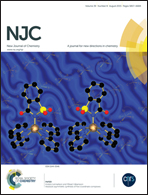Efficient synthetic supramolecular channels and their light-deactivated ion transport in bilayer lipid membranes†
Abstract
Inspired by the critical role of ion channel proteins in the regulation of cellular activities, here we developed a new type of synthetic ion channel by simple benzocrown ether-based derivatives M1 and M2, where M1 had a dodecyl tail and M2 had a diethylene glycol-conjugated dodecyl tail. Being amphiphilic in nature, the two small molecules were assumed to form crown ether channels through supramolecular interactions in bilayer lipid membranes (BLMs). The efficient ion transport was investigated by both a fluorescence-based vesicle assay and a planar bilayer conductance measurement, and M2 with diethylene glycol substitution exhibited more efficient activity comparable to amphotericin B. Moreover, the presence of a photosensitive o-nitrobenzyl group provided the light-regulation to deactivate ion transport by destroying the channel assembly of the molecules in BLMs, which provides new opportunities for developing intelligent light-regulated systems for biomedical applications based on synthetic small molecules.


 Please wait while we load your content...
Please wait while we load your content...